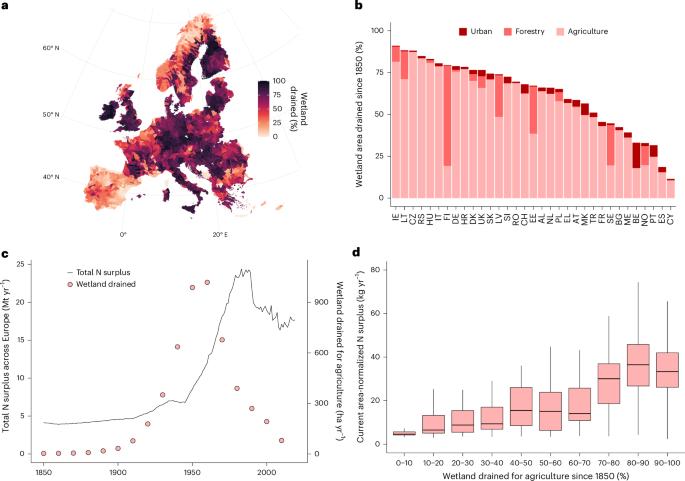The important role of wetland conservation and restoration in nitrogen removal across European river basins
IF 24.1
引用次数: 0
Abstract
In Europe, excessive inputs of nitrogen threaten ecosystems and public health. Wetlands act as natural filters, removing excess nutrients and protecting downstream waters. Using high-resolution data on nitrogen surplus and wetland distribution, we estimate that existing European wetlands remove 1,092 ± 95 kt of nitrogen per year. Restoring 27% of wetlands historically drained for agriculture (3% of land area), targeted in high nitrogen input areas, could reduce current nitrogen loads to the sea by 36%, but with potential costs to agricultural productivity. A more efficient strategy targets wetland restoration on farmlands projected to be abandoned by 2040, yielding a 22% load reduction and enabling major rivers such as the Rhine, Elbe and Vistula to meet water quality targets with minimal agricultural impact. Our findings highlight wetland restoration as a cost-effective, policy-relevant solution that, if spatially targeted, can deliver major water quality improvements while supporting the European Union’s broader goals on climate, biodiversity and agricultural sustainability. This study evaluates the potential of wetland conservation and restoration to improve water quality and highlights the important role of wetlands in nitrogen removal across European river basins.

湿地保护和恢复在欧洲河流流域氮去除中的重要作用
在欧洲,氮的过量输入威胁着生态系统和公众健康。湿地就像天然的过滤器,去除多余的营养物质,保护下游水域。利用氮剩余和湿地分布的高分辨率数据,我们估计现有的欧洲湿地每年去除1092±95 kt氮。恢复27%的历史上用于农业的湿地(占陆地面积的3%),目标是高氮投入地区,可以减少目前流入海洋的氮负荷36%,但可能会对农业生产力造成损失。更有效的策略是在2040年之前对废弃农田进行湿地恢复,减少22%的负荷,并使莱茵河、易北河和维斯瓦河等主要河流在对农业影响最小的情况下达到水质目标。我们的研究结果强调,湿地恢复是一种具有成本效益的、与政策相关的解决方案,如果在空间上有针对性,可以实现重大的水质改善,同时支持欧盟在气候、生物多样性和农业可持续性方面的更广泛目标。本研究评估了湿地保护和恢复在改善水质方面的潜力,并强调了湿地在欧洲河流流域氮去除中的重要作用。
本文章由计算机程序翻译,如有差异,请以英文原文为准。
求助全文
约1分钟内获得全文
求助全文

 求助内容:
求助内容: 应助结果提醒方式:
应助结果提醒方式:


